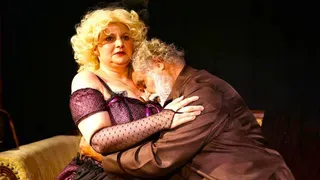October 15, 2009
How to Be A Movie Star: Elizabeth Taylor in Hollywood
Kilian Melloy READ TIME: 3 MIN.
If, as film historian Jeanine Basinger has it, movie stardom is an inexplicable--but immediately recognizable--quality, then William J. Mann's new Elizabeth Taylor biography, How to Be A Movie Star: Elizabeth Taylor in Hollywood is the first and last word on its chosen subjects--namely, movie stardom and Elizabeth Taylor herself, an epitome of the mysterious quality that makes the screen come alive.
This is a rare case in which it is possible to judge a book by its cover: the stunning photo of a young Elizabeth Taylor that graces the dust jacket constitutes a genuine preview of the book's toe-curling delights.
This is Elizabeth Taylor as we have always seen her, and always wanted to see her: glamorous, yet earthy; celestial in her beauty and yet accessible; a woman who can drip with jewels and still eat cold fried chicken with her bare hands. Mann celebrates Taylor, just as men everywhere celebrate her.
But Mann doesn't need to leave anything out of her story in order to deliver enchantment. Taylor, in these pages, is a heavy drinker, a romantically stifled young woman, and powerful romantic partner as she comes into her own; it's no wonder the account that Mann has written opens with a peek at Taylor's notoriously red-hot affair with Richard Burton, which sparked to life in Italy during the production of Cleopatra.
After this prologue, Mann starts the story over, from the beginning: a young Elizabeth Taylor is promoted by her ambitious mother, who recruits the all-powerful celebrity gossip columnist Hedda Hopper to help get the girl's career in movies rolling. Elizabeth lands the starring role in National Velvet (legend has it that she grew an astounding three inches in just a few months to secure the part; a lucky growth spurt? Or Hollywood legerdemain? Either way, it's a s delicious as the big breakfasts Elizabeth's mother stuffs her with each morning to encourage her growth) and she's off and away.
Mann delves behind the marriages, the affairs, the bouts with illness, the studio-arranged life that Taylor lived and eventually broke away from. From time to time, Mann almost suggests that Taylor's illnesses were a little too convenient; however, his point is not that she was malingering, so much as that she knew by instinct, generations before today's crop of starlets, how to interface her personal and professional lives with the public, who adored her for it. Taylor lived out loud, and the world sang along to her tune.
Except, that is, for her scandalous affair with Burton, the one episode in her highly unconventional life that might have swamped Taylor's career and sunk her glamor.
But no: the times were changing, and Taylor's beauty and charm, immense as they were, proved enough to lift her out of opprobrium. It's a glorious arc, worthy of any of Taylor's best roles. But then again, that seems to be the point: there's no better advice when it comes to how to be a movie star that to look at what Taylor did. She simply was a star, born to the role, and she's played it all her life.
Taylor also knew when to step back a little, and so does Mann, who ends the book with Taylor's exit from film (with occasional minor returns to the form) and her triumphant re-invention as a star of the stage. By that point, the reader is drunk and happy on something even more potent than Taylor's frequent comfortives, and there's no word for it other than radiance: the sort cast by a genuine star.
Kilian Melloy serves as EDGE Media Network's Associate Arts Editor and Staff Contributor. His professional memberships include the National Lesbian & Gay Journalists Association, the Boston Online Film Critics Association, The Gay and Lesbian Entertainment Critics Association, and the Boston Theater Critics Association's Elliot Norton Awards Committee.




